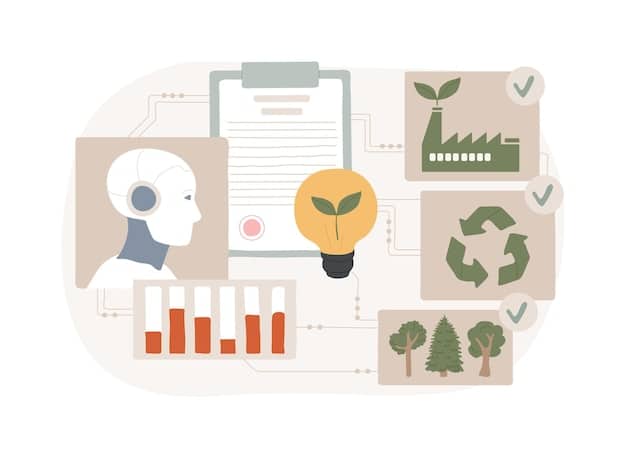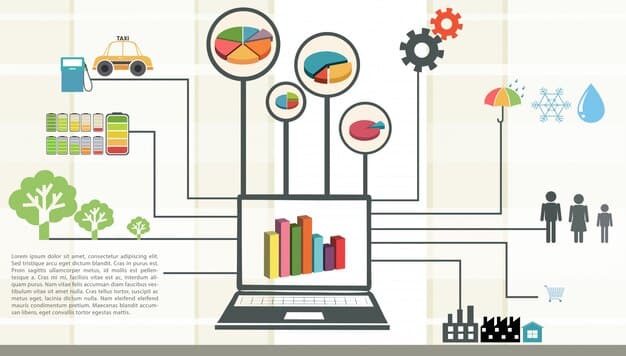US Corporate Sustainability Reporting: Impact in 2025 and Beyond

Navigating the evolving landscape of US corporate sustainability reporting requirements in 2025 will demand strategic adaptation, meticulous data collection, and proactive engagement with new regulations, profoundly influencing business operations and stakeholder perceptions across sectors.
The regulatory landscape for corporate sustainability in the United States is undergoing significant transformation, posing pressing questions for businesses nationwide. Understanding How Will the Updated US Corporate Sustainability Reporting Requirements Impact Your Business in 2025? is not merely an academic exercise; it is a critical imperative for strategic planning, operational adjustments, and competitive positioning as the deadline approaches.
The evolving regulatory landscape: a new era of transparency
The imperative for corporate sustainability reporting has intensified in recent years, driven by growing investor demand, public pressure, and a clearer understanding of climate-related financial risks. While voluntary frameworks have long existed, the trend in the US points towards mandatory, standardized disclosures. This shift marks a significant pivot, moving sustainability from a niche concern to a core business imperative, subject to regulatory scrutiny. Businesses must grasp that this isn’t just about ‘doing good’; it’s about robust risk management and strategic foresight.
For decades, sustainability initiatives were often viewed as separate from core financial reporting, largely driven by corporate social responsibility (CSR) departments or niche investor groups. However, the escalating climate crisis, coupled with increasing stakeholder awareness regarding environmental, social, and governance (ESG) factors, has propelled sustainability into the boardroom. Regulators, noting the financial implications of climate change and social inequities, have begun to mandate more structured and comparable reporting. This evolution is vital for ensuring market integrity and facilitating informed capital allocation.
Key drivers of change
Several powerful forces are converging to redefine current reporting requirements. Understanding these drivers is crucial for businesses to anticipate future expectations and build resilient strategies.
- Investor demand: Asset managers and institutional investors are increasingly incorporating ESG criteria into their investment decisions, pushing for standardized, reliable data to assess risks and opportunities.
- Climate risk mitigation: Governments and financial bodies recognize that climate change poses systemic risks to the economy, necessitating transparent disclosure of climate-related exposures and strategies.
- Global harmonization efforts: International frameworks, such as those from the International Sustainability Standards Board (ISSB), are influencing US policy, aiming for greater comparability across jurisdictions.
- Public and consumer pressure: Consumers and the broader public are demanding greater accountability from companies regarding their environmental footprint and social impact, driving reputation and brand value.
The regulatory trajectory suggests a future where sustainability reporting is as rigorous and material as financial reporting. This requires not only gathering data but integrating sustainability considerations into core business strategy. Ignoring these signals could lead to significant competitive disadvantages and increased regulatory exposure. Proactive engagement with these evolving standards will be a hallmark of successful businesses in 2025 and beyond.
Decoding the primary reporting frameworks: SEC, FASB, and beyond
When considering US corporate sustainability reporting, several key players emerge, each contributing to a complex, albeit increasingly interconnected, regulatory tapestry. The Securities and Exchange Commission (SEC) is arguably the most influential, given its mandate over public company disclosures. However, other bodies, like the Financial Accounting Standards Board (FASB) and even state-level initiatives, play roles that businesses cannot afford to overlook. Navigating these various frameworks often feels like a multi-dimensional puzzle, requiring careful alignment of data and disclosures.
The SEC’s anticipated climate-related disclosure rule, though subject to legal challenges and revisions, represents a monumental shift. Its objective is to provide investors with consistent, comparable, and reliable information to assess climate-related risks and opportunities. This includes reporting on greenhouse gas (GHG) emissions (Scopes 1, 2, and potentially 3), climate-related financial impacts, and governance structures related to climate oversight. The impact of this rule could extend far beyond publicly traded companies, influencing their private value chain partners.

Key frameworks and their implications
Understanding the nuances of each framework is crucial for tailoring reporting strategies and ensuring compliance. Misinterpretations can lead to significant penalties or reputational damage.
- SEC Climate Disclosure Rule: This rule is designed to standardize disclosures concerning climate-related risks (physical and transition), governance of climate risks, and specific climate-related financial metrics, including GHG emissions. Its phased implementation often begins with larger accelerated filers.
- California Climate Disclosure Laws (SB 253 & SB 261): These state-level mandates require large public and private companies doing business in California to report their GHG emissions (SB 253, the Climate Corporate Data Accountability Act) and climate-related financial risks (SB 261, the Climate-Related Financial Risk Act). These could serve as a bellwether for other states.
- FASB’s Role: While FASB traditionally focuses on financial accounting standards, there is growing dialogue on how sustainability-related financial impacts might be better reflected in traditional financial statements. This could involve new guidance on intangible assets, liabilities, or even revenue recognition tied to sustainability performance.
The interplay among these frameworks means that companies cannot simply view them in isolation. Data collected for SEC disclosures might also fulfill requirements for California laws, and vice-versa. Moreover, international standards, like those from the ISSB, are increasingly being considered by US regulators, suggesting a future convergence of reporting practices. Businesses should aim for flexible data collection systems that can adapt to evolving requirements and provide robust, auditable information across multiple frameworks. This forward-looking approach minimizes redundancy and maximizes efficiency.
Operational and financial impacts on your business
The updated sustainability reporting requirements are far from mere paperwork; they represent fundamental shifts that will ripple through every facet of a business, from day-to-day operations to long-term financial health. The impacts extend beyond compliance, touching areas like supply chain management, capital allocation, talent acquisition, and brand reputation. Companies must view these changes not as a burden, but as an opportunity to enhance efficiency and competitiveness.
One of the most immediate operational impacts will be on data collection and management. Companies will need robust systems to gather, verify, and report highly granular data on GHG emissions, energy consumption, waste generation, water usage, and various social metrics. This often necessitates investments in new technologies, training for personnel, and a re-evaluation of internal processes. Supply chain engagement will also become critical, as many emissions and social impacts occur upstream and downstream from a company’s direct operations. This demands greater transparency and collaboration with suppliers and partners.
Key areas of impact
Understanding where the most significant changes will occur helps businesses prioritize resources and develop targeted strategies for adaptation.
- Data infrastructure and assurance: Companies will need to invest in systems capable of collecting, storing, and validating vast amounts of sustainability data. External assurance of this data will likely become standard, similar to financial audits.
- Supply chain transformation: Enhanced reporting on Scope 3 emissions will push companies to scrutinize and influence the practices of their suppliers, potentially leading to supply chain optimization and increased collaboration.
- Capital and financing: Access to capital may become increasingly linked to sustainability performance. Lenders and investors are already offering preferential terms to companies with strong ESG credentials and comprehensive disclosures, reducing the cost of capital.
- Talent acquisition and retention: A strong commitment to sustainability, backed by transparent reporting, can enhance employee morale and attract top talent, particularly younger generations who prioritize purpose-driven organizations.
- Reputation and brand value: Accurate and comprehensive sustainability reporting builds trust with customers, investors, and the public. Conversely, inadequate reporting or perceived greenwashing can severely damage brand reputation.
Financially, the implications are equally profound. While initial compliance costs might seem prohibitive, the long-term benefits include reduced operational costs through efficiency gains, enhanced access to green financing, improved risk assessment, and potentially higher valuations from ESG-focused investors. Furthermore, avoiding penalties for non-compliance and hedging against future carbon regulations will provide a distinct financial advantage. Embracing these reforms strategically means turning regulatory challenges into pillars of sustainable growth and profitability.
Strategies for compliance and leveraging sustainability as a competitive advantage
Meeting the updated US sustainability reporting requirements in 2025 demands more than just fulfilling a mandate; it calls for a strategic approach that integrates sustainability into the core business model. Simply ticking boxes will not suffice. Instead, companies that proactively embrace these changes can transform compliance into a powerful competitive advantage, fostering innovation, strengthening investor relations, and enhancing long-term resilience.
The first step is often a comprehensive gap analysis: understanding where a company’s current data collection and reporting capabilities stand against the impending regulations. This often reveals significant needs for new processes, technologies, and internal expertise. Building a dedicated cross-functional team, involving finance, operations, legal, HR, and sustainability departments, is crucial for a coordinated effort. This team can then develop a detailed roadmap for data collection, system implementation, and external assurance processes, ensuring that data is both robust and auditable.
Proactive compliance and strategic benefits
Beyond basic compliance, several strategies can help businesses not only meet requirements but thrive in this new environment.
- Integrate data management: Move beyond siloed data by integrating sustainability data collection with existing financial and operational systems. This ensures consistency, reduces manual errors, and streamlines reporting.
- Engage the supply chain: Proactively work with suppliers to gather necessary Scope 3 data and collaborate on emission reduction initiatives. This can foster stronger partnerships and contribute to collective sustainability goals.
- Seek external assurance: Obtaining independent assurance for sustainability reports lends credibility, reduces the risk of misstatement, and builds trust with stakeholders.
- Innovate for efficiency: Use data derived from reporting to identify opportunities for resource efficiency, waste reduction, and energy savings. These operational improvements often yield significant cost savings.
- Communicate proactively: Develop clear, transparent communication strategies around sustainability efforts and performance. This helps manage stakeholder expectations, mitigates reputational risks, and highlights progress.
Leveraging sustainability as a competitive advantage also involves recognizing its role in attracting and retaining talent, appealing to purpose-driven consumers, and accessing preferential financing. Companies that can demonstrate a clear, measurable commitment to sustainability are often viewed more favorably by investors, leading to lower capital costs and enhanced valuations. By moving beyond reactive compliance to proactive integration, businesses can position themselves as leaders in the sustainable economy, unlocking new growth opportunities and building enduring value.
Overcoming common challenges and pitfalls
While the benefits of robust sustainability reporting are clear, the path to achieving compliance and leveraging these new requirements is fraught with challenges. Businesses, especially those new to comprehensive ESG reporting, will encounter significant hurdles. Acknowledging these potential pitfalls upfront allows companies to develop proactive strategies to mitigate risks and ensure a smoother transition. Ignoring them can lead to costly remediation and even regulatory penalties.
One of the most pervasive challenges is data availability and quality. Many companies lack the sophisticated systems needed to collect, track, and verify the granular sustainability data required by new regulations – particularly for Scope 3 emissions, which involve upstream and downstream activities beyond a company’s direct control. This necessitates engaging with suppliers and partners, which can be complex and time-consuming. Moreover, ensuring the reliability and auditability of this data is critical, as inaccuracies can undermine credibility and invite scrutiny.

Anticipating and addressing hurdles
Identifying common obstacles and formulating clear strategies to overcome them is key to successful implementation.
- Data collection and accuracy: Implement robust data management systems and conduct internal audits to ensure accuracy. Prioritize automating data collection where possible to reduce human error.
- Scope 3 emissions complexity: Develop strategies for engaging value chain partners to gather relevant data. Consider industry-specific methodologies and external consultants to navigate this intricate area.
- Resource allocation: Allocate sufficient financial and human resources for compliance. This includes investing in new software, hiring specialized personnel, or partnering with external experts.
- Internal buy-in and training: Foster a culture of sustainability across the organization. Provide comprehensive training to employees on new reporting requirements and their roles in data collection.
- Evolving regulatory landscape: Stay abreast of ongoing changes in regulations and standards. Maintain flexibility in reporting frameworks to adapt to future mandates.
Another significant pitfall is the risk of “greenwashing,” where companies make unsubstantiated or misleading claims about their sustainability efforts. With enhanced transparency, such practices are quickly exposed, leading to severe reputational damage and legal repercussions. To avoid this, disclosures must be authentic, verifiable, and clearly communicated. Companies should invest in third-party assurance of their data and claims to build stakeholder trust. By proactively addressing these challenges, businesses can navigate the new reporting landscape effectively, establishing themselves as creditable and truly sustainable enterprises.
The role of technology in automating and streamlining reporting
The sheer volume and complexity of data required by updated sustainability reporting frameworks make manual processes untenable for most medium to large enterprises. This is where technology emerges as an indispensable ally, transforming what could be an overwhelming burden into a manageable, data-driven opportunity. From AI-powered analytics to blockchain for supply chain transparency, technological solutions are pivotal in automating, streamlining, and enhancing the accuracy of sustainability disclosures.
Sustainability reporting software, often integrated with existing ERP or financial systems, is becoming standard practice. These platforms can automate data collection from various sources – energy meters, financial records, supplier surveys – and consolidate it into a centralized database. Such systems allow for real-time tracking of key performance indicators (KPIs), identify data gaps, and generate reports compliant with various standards (e.g., SEC, GRI, SASB). Automating these processes significantly reduces the manual effort, minimizes errors, and ensures timely reporting, which is critical given the increasing frequency of disclosures.
Technological enablers for efficient reporting
Leveraging the right technologies can significantly improve the efficiency, accuracy, and strategic value of sustainability reporting.
- ESG reporting software platforms: These dedicated solutions help companies collect, manage, analyze, and report on ESG data, often providing built-in compliance templates for various regulations.
- Data analytics and AI: Tools powered by AI and machine learning can process vast datasets, identify trends, predict future impacts, and even flag anomalies, improving the quality and reliability of reported data.
- Internet of Things (IoT) sensors: IoT devices can provide real-time data on energy consumption, water usage, and waste generation, offering precise and continuous monitoring that manual methods cannot achieve.
- Cloud computing: Cloud-based solutions offer scalable infrastructure for data storage and processing, making it easier for companies to handle growing data volumes and collaborate across different locations.
- Blockchain for supply chain: Blockchain technology can enhance transparency and traceability within complex supply chains, verifying the provenance of materials and ensuring ethical sourcing, which is crucial for Scope 3 emissions reporting and social responsibility.
Beyond mere automation, technology also facilitates advanced analytics, allowing companies to derive deeper insights from their sustainability data. This enables more informed decision-making, identifies opportunities for efficiency gains, and supports strategic planning. For instance, predictive analytics can help forecast future emissions based on operational changes, allowing for proactive mitigation strategies. Moreover, technology enhances the auditability and integrity of reported data, a crucial aspect as regulatory scrutiny increases. Embracing these technological solutions is no longer optional; it is fundamental to navigating the evolving landscape of corporate sustainability with confidence and strategic advantage.
Future outlook: beyond 2025 and long-term implications
While the immediate focus is on the 2025 deadlines for updated US corporate sustainability reporting, it is crucial for businesses to look beyond this initial horizon. The current regulatory shifts are not isolated events but rather part of a broader, sustained movement towards comprehensive corporate accountability. Sustainability reporting is evolving into an ongoing strategic function, demanding continuous adaptation and foresight. Companies that view 2025 as a one-off compliance exercise risk falling behind financially and reputationally in the years that follow.
The trajectory suggests an increasing harmonization of global sustainability standards, with frameworks like the ISSB gaining wider acceptance. This will likely push US regulations towards greater convergence with international norms, potentially simplifying multi-national reporting but requiring continuous monitoring of evolving global best practices. Furthermore, the scope of reporting is likely to broaden, extending beyond climate to encompass a wider array of social and governance issues. This could include more detailed disclosures on human rights, biodiversity impacts, and diversity, equity, and inclusion (DEI) metrics, reflecting holistic ESG considerations.
Long-term strategic considerations
Planning for the long term involves anticipating future trends and embedding sustainability deeply into organizational culture and strategy.
- Continuous regulatory evolution: Expect ongoing refinements and expansions of reporting requirements, necessitating flexible systems and continuous professional development for reporting teams.
- Integration with financial disclosures: The distinction between financial and sustainability reporting will likely blur further, with sustainability data becoming an increasingly integrated part of financial statements.
- Increased assurance and enforcement: Regulatory bodies will likely strengthen their enforcement mechanisms, emphasizing independent assurance for sustainability data, akin to financial audits.
- Focus on impact measurement: Moving beyond simple disclosure, future reporting may place greater emphasis on demonstrating actual, measurable positive (or negative) impacts, rather than just activities.
- Competitive differentiation: Strong, transparent sustainability performance will become a key differentiator in attracting investors, customers, and talent, driving market value and long-term growth.
The long-term implications include a paradigm shift towards “integrated thinking,” where financial and non-financial performance metrics are intrinsically linked in corporate strategy and communication. Companies that embed sustainability into their core operations, governance, and innovation processes will be better positioned to manage risks, seize opportunities, and build enduring value. This strategic foresight ensures not only compliance but also resilience and leadership in a rapidly transforming global economy. The journey towards comprehensive sustainability reporting is continuous; 2025 is merely a significant milestone, not the destination.
| Key Aspect | Brief Description |
|---|---|
| 📊 Compliance Need | New SEC and state-level rules demand granular, standardized sustainability data reporting. |
| ⚙️ Operational Impact | Requires robust data systems, supply chain engagement, and potentially new tech investments. |
| 💰 Financial Outcome | Influences capital access, cost of financing, and long-term valuation for businesses. |
| ✅ Strategic Advantage | Proactive response builds trust, attracts talent, and enhances market competitiveness. |
Frequently asked questions about sustainability reporting
The primary requirements include the SEC’s proposed climate-related disclosure rule, which mandates reporting on climate risks, governance, and GHG emissions (Scopes 1, 2, and potentially 3). Additionally, California’s SB 253 and SB 261 will require emissions and climate risk disclosures for certain large companies operating in the state, establishing significant precedents for corporate transparency.
Publicly traded companies, especially larger accelerated filers, will experience the most direct impact from SEC rules. However, private companies, particularly those in the supply chains of public entities or those operating in California, will also be significantly affected due to Scope 3 reporting requirements and new state laws. Financial institutions are also heavily impacted as they assess portfolio risks.
Scope 3 emissions, which cover indirect emissions from a company’s value chain, are often the largest portion of a company’s carbon footprint. Reporting them significantly increases transparency and accountability. It necessitates collaboration with suppliers and customers, driving broader decarbonization efforts across entire industries rather than just individual company operations, posing a significant data challenge.
Technology is crucial for compliance. ESG reporting software automates data collection, management, and reporting, reducing manual effort and errors. AI and data analytics can identify trends and improve data accuracy. IoT sensors offer real-time operational data, and blockchain can enhance supply chain transparency. These tools streamline processes and provide auditable, reliable disclosures.
Beyond compliance, proactive sustainability reporting enhances corporate reputation, attracts ESG-focused investors, reduces the cost of capital, and improves access to green financing. It also fosters operational efficiencies, attracts top talent, and mitigates future regulatory and climate-related risks, positioning the business for long-term resilience and sustained competitive advantage within evolving markets.
Conclusion
The updated US corporate sustainability reporting requirements for 2025 represent a pivotal moment for businesses. Far from being a mere compliance exercise, these mandates signal a fundamental shift towards greater transparency, accountability, and integration of environmental and social considerations into core business strategy. Proactively adapting to these changes, investing in robust data infrastructure, and fostering internal expertise will not only ensure regulatory adherence but also unlock significant competitive advantages, driving innovation, enhancing stakeholder trust, and securing long-term economic resilience in an increasingly sustainability-driven global economy.





